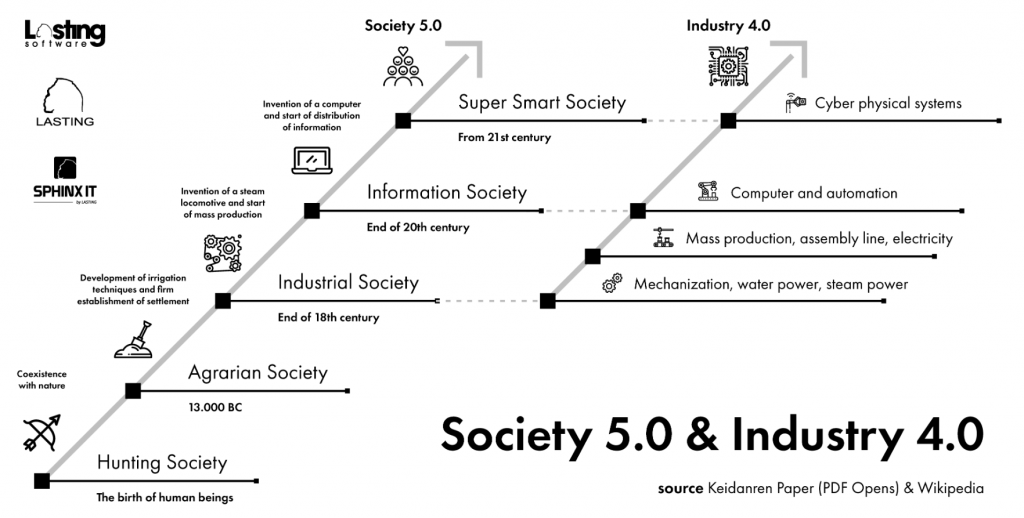Japan have started a strong project that expands the concept of Industry 4.0 to society, benefiting it through the use of Artificial Intelligence, Blockchain, Internet of Things and several other technologies.

The idea is to incorporate the technological innovations that we have followed during the fourth industrial revolution to create a new social and economic context, surpassing the information society and placing technology as a source for solving problems in several sectors that are considered the main pillars of this transformation: infrastructure, financial technology, health, logistics and Artificial Intelligence (AI).
Before we go on to the Society 5.0 topic, let’s talk about some related topics.
Industrial Revolutions & Industrie 4.0
- The first industrial revolution happened in England at the end of the 18th century and changed the world paradigm by accelerating the production process, the one that was completely artisanal, by the use of coal, steam and iron. Production reached levels never before seen at the time. The British have become the world’s leading position due to be able to produce products cheaply and quickly.
- The second industrial revolution took place in the middle of the 19th century, with electricity, chemistry and oil as main actors and that period was remarked by the manufacturing massification, and the technologies development as the airplane, refrigerators, and telephones.
- The third industrial revolution just happened and is part of the current generations. From the second half of the 20th century, information became an important raw material. The first computers appeared and increased the speed of scientific development process, as other areas of knowledge. It brought electronics, information technology and telecommunications as we know today.
- The fourth industrial revolution, or Industry 4.0, is a concept developed by Klaus Schwab, director and founder of the World Economic Forum and according to him, industrialization has reached a fourth phase, which again “will fundamentally transform the way we live, work and relate”. It is a complete paradigm changing, composed by benefits and challenges. Using the third industrial revolution technologies as a foundation, industry 4.0 tends to be fully automated from systems that combine machines with digital processes. It is called the “smart factory”. For Klaus Schwab, “the fourth industrial revolution is not defined by a set of emerging technologies in themselves, but the transition towards new systems that were built on the infrastructure of the digital revolution”.
Digital Transformation
Digital Transformation it’s a very used and present term, used during the last years and, for sure, in the next ones too. It’s a process in which companies use technology to improve their performance, expand their reach and optimize results. This transformation generates a change of mindset throughout the company, both internally and externally, for customers. Digital transformation will dramatically alter many aspects of society, including private lives, public administration, industrial structure, and employment. Utilization of data and AI will open up many new possibilities. The important questions are what to use these technologies for, how to go to that direction and when to do it? The real true is: there are many methodologies, good practices, and specialized professionals that can take care about it and for sure this is important, but it’s so important too to keep in mind that is not a optional thing, due to there is no question like “should my business get digital?”, but actually “when is my business going to get digital?” and even more importante, “Am I prepared for it?”.
A good, recent and short example of a not optional digital transformation is the situation we are facing during the COVID-19 pandemic. It happened during a time where not all people and companies are comfortable to be working in distance, someones by trusting issues, another by leadership difficult, but just the prepared ones by technical infrastructure, organizational culture, and professional profile, were able to adapte the business model faster and much more softly then another ones. To be on track of the digital transformation, it’s not wait for it to get actions, but be prepared before it.
Society 5.0 – Super Smart Society

The concept comes from the proposal of the 5th Basic Science and Technology Plan, available with more details here in the official Japan Govern page. The expectation of that is to improve human capacities to interact with technologies, using them not only to develop the economy, but to promote well-being. Society 5.0 is the vision for the next stage in the evolution of human society, following its previous stages as a hunter-gatherer society (Society 1.0), agrarian society (Society 2.0), industrial society (Society 3.0), and information society (Society 4.0).

So far, the application of intelligent tools is mostly centered in factories, in favor of productivity and process efficiency. What is envisioned, however, is the repositioning of technologies created in favor of the entire community to improve the quality of life of the population and to place the human being as the main recipient of innovation and technological transformation.
Society 5.0 is an expansion of the concept of industry 4.0, where while it is geared towards digital transformation in manufacturing, 5.0 intends to be incorporated at all levels of society to face common challenges to the population, such as the crisis in systems health care during pandemic times.
Values
The aim of the Society 5.0 is to centralize technology in social welfare, to better and usefully enjoy life. The methodology seeks to fulfill its goals based on three fundamental values:
- Quality of life: Through this innovative concept of impact at a global level, the wish is to bring more comfortable and quality life, regardless of gender, race or age. The idea is that, even in the work environment, the heaviest tasks are replaced by intelligent tools and machinery, transferring the worker to more intellectual tasks.
- Inclusion: it is intended that all citizens have equal access to the tools and benefits attributed by the proposal. After all, the idea is precisely to be incorporated into society in a broad and isonomic way to combat social inequalities and meet future challenges.
- Sustainability: is a key word for the changes that will be implemented after the Society 5.0. It is understood that, although positive, economically mass production still causes irreversible impacts to the planet. Contrary to what was thought until then, it is intended to implement technologies in favor of the environment, such as expansion of renewable energies and reduction of polluting materials.
Technologies and Functionalities

To implement the Society 5.0 concept, several technologies in favor of well-being can be used and they,many times, complement each other.

- Big Data: the large volume of data, structured or not, generated daily by the institutions. The tool, which is directly related to the Information Age, ensures a more accurate analysis of reality and allows you to make better decisions for several common problems.
- Artificial intelligence: the ability of machines and systems to make decisions without human interference.
- Machine learning, allows machines to learn from experience.
- Internet of things: also known by the acronym IoT (internet of things), it is the technology that allows objects and things anything in general to be connected to the network and work more efficiently through the collection and interpretation of data.

- Cloud computing: with this technology and thanks to the increase in connection speed, complex systems can run on increasingly smaller hardware, using all internet connections capabilities over remote servers.
- Renewable energies: for machines and robots to work, energy generation is required. The difference is that, in Society 5.0, finite energy resources, such as oil and coal, will not be used, but renewable, such as the sun and wind.
- Robotics: will take care of heavy services in agriculture, cleaning and other branches, reducing work accidents involving human beings.
- Tele-medicine: less and less physical presence of doctors and other health professionals will be required. Care and even complex surgeries can be conducted remotely.
- Autonomous driving: for transporting people and cargo, to operate without a pilot. It includes various technologies that we are talking about here: artificial intelligence, internet of things, cloud computing and renewable energy.

- Drones: unmanned aerial vehicles should be increasingly used for delivering goods and responding to disasters.
- Smart home: it the user of with the internet of things and artificial intelligence making homes more connected, efficient and comfortable.
- Blockchain: is the data structure that represents a financial accounting entry or a record of a transaction. Each transaction is digitally signed with the aim of guaranteeing its authenticity and ensuring that no one tamper with it, so that the registry itself and the transactions within it are considered to be of high integrity. It can be used in Society 5.0 for several processing data process besides the financials one to provide a convergent and secure platform.
Author
- BI System Analyst, Computer Engineer & Developer
- “Networking it’s not about how many connections you have, but the much you are really connected to them. - Let’s learn, let’s share.”
Latest entries
- November 1, 2020PeopleI’m not an Analyst.
- August 19, 2020TechnologyWhat about Society 5.0
- August 18, 2020TechnologyWhat about UI (User Interface)?
- August 9, 2020DevelopmentHow to create your first CDS View

